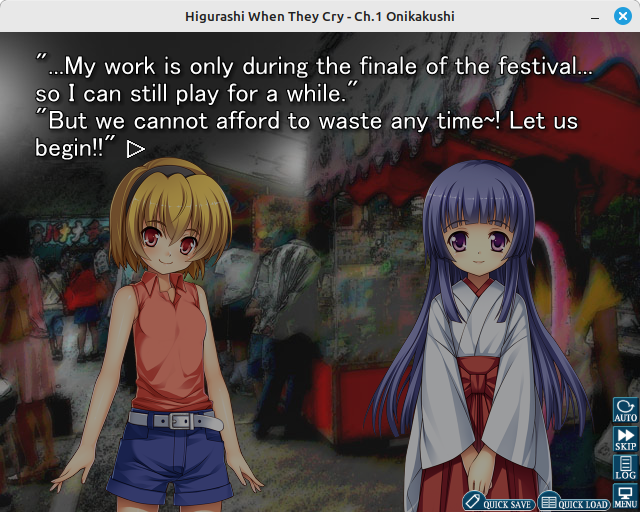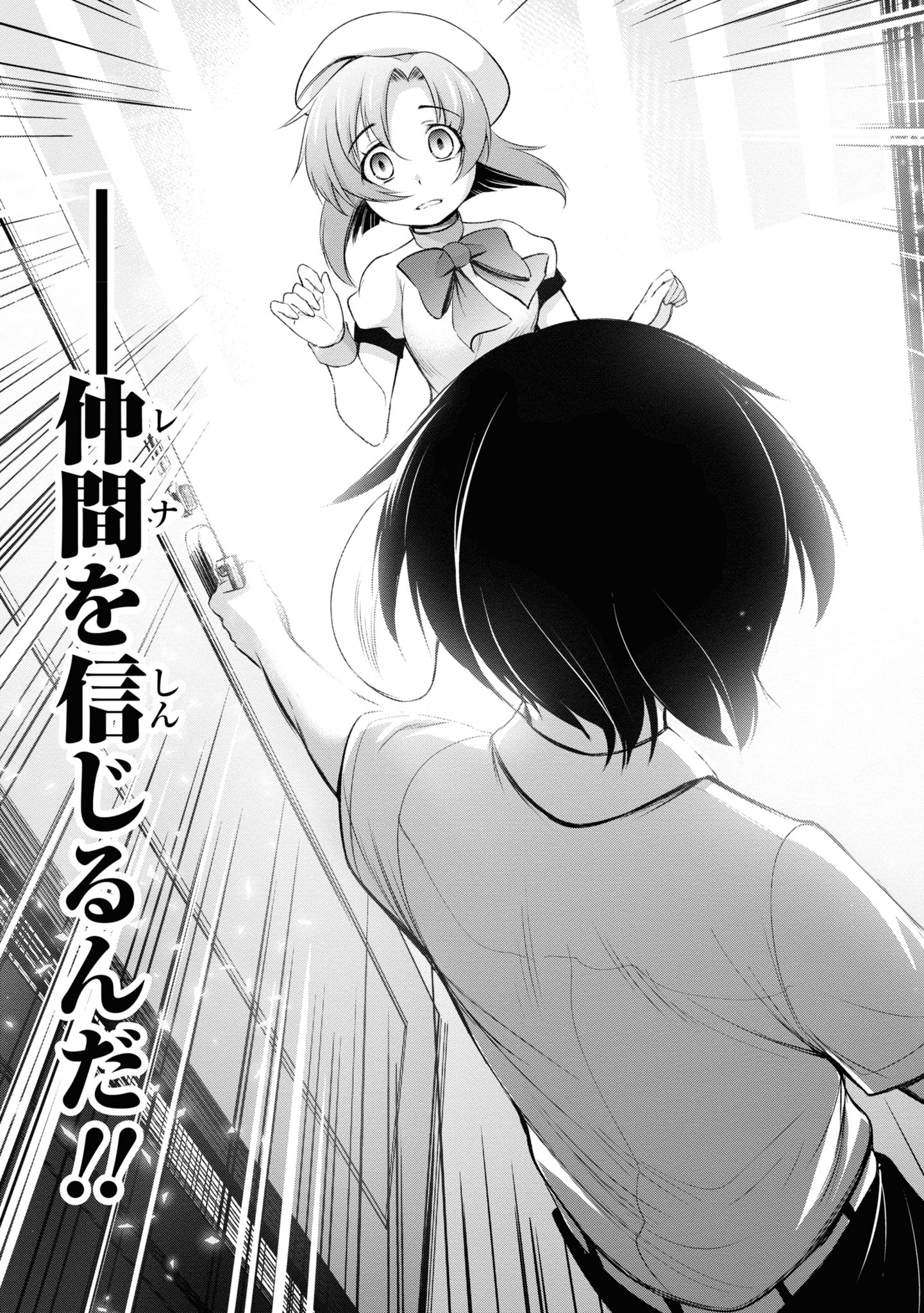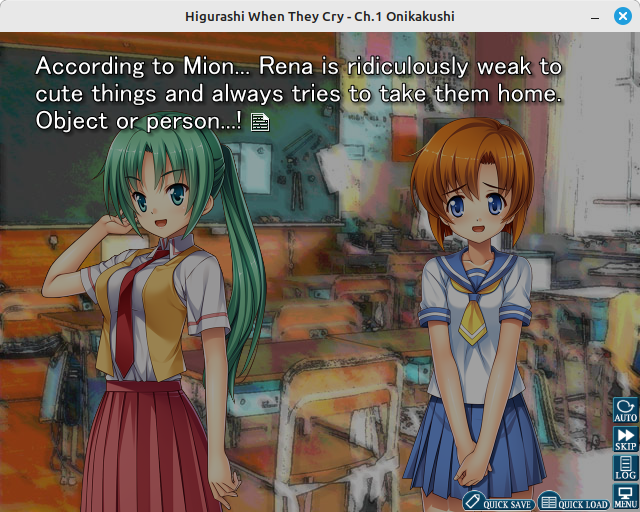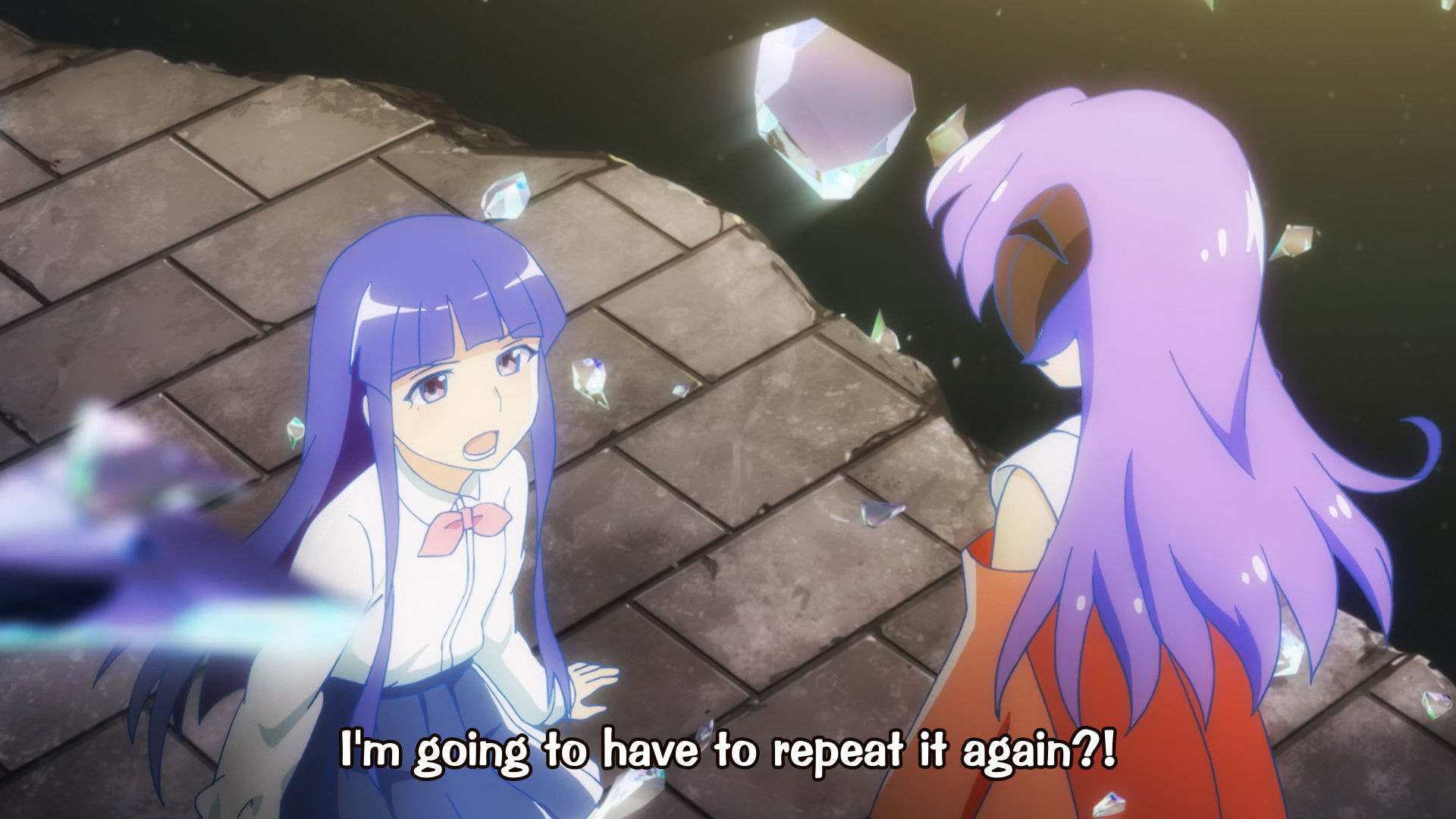The zombification of Higurashi When They Cry
Posted 2025-03-16 17:13 JSTThe 2000's were a magical time
Way back in 2002, a humble little creator calling himself Ryukishi07 attended Summer Comiket. He was selling a short visual novel he had made called ひぐらしのなく頃に 鬼隠し編. Or, in English, Higurashi When They Cry: Demons Abducting, with "higurashi" being a type of cicada with a distinctive cry, evoking images of summer. And yes, the red is a specific part of the title. I can't be assed to type out span tags for it every time, though, which is why I didn't do it on the Manga page of this website.
It depicted a sleepy little countryside village in June 1983 called Hinamizawa. What began as a simple, idyllic story soon spiraled into a tragic horror mystery culminating with the perspective character, Maebara Keiichi, brutally beating his friends, local yakuza heiress Sonozaki Mion and girl-next-door Ryuuguu Rena, to death in self-defense before scratching his own throat out while on the phone with the cops. What exactly happened in Hinamizawa remained unexplained, the story ending on the cops reading Keiichi's last testament: "Whoever you are reading this, please find the truth. That is my only wish."
It was a hit. Over the next four years, Ryukishi07 released three more "question arcs," two of them (Watanagashi-hen, "Cotton Drifting," and Tatarigoroshi-hen, "Curse Killing") depicting equally cryptic alternate realities of Hinamizawa's June 1983 and the last (Himatsubushi-hen, "Time Wasting") traveling four years into the past to set up the true central mystery of the series, followed by four "answer arcs" belonging to a series with a similar name but an added subtitle: ひぐらしのなく頃に解, Higurashi When They Cry Solved. These served to provide another perspective on the mysteries presented in the question arcs, with the last one ultimately ending in the main characters overcoming the tragedy and reaching a happy ending.
Higurashi started as a supernatural-looking horror story, but as it went on, it proved to have very few supernatural elements to it at all, and they only served as mere framing to the mystery anyway: little Furude Rika is the priestess of the local god, Oyashiro-sama (who has by now devolved into a shadow of her former self, taking the form of a little girl named Hanyuu), by whose power she resurrects into another world (or, in Higurashi's parlance, "fragment") whenever she dies. This isn't just an attempt to handwave the existence of multiple versions of the same story; it's the central mystery of the series. Who kills Rika, for what reason, and how can they be stopped? Will Rika ever be able to escape her endless loop of June 1983? I mean, I just said she does in the last paragraph, but you know. I write these things stream-of-consciousness, okay?

To say people liked Higurashi would be to say I yearn for the loving touch of a woman. The eighth and final installment of the main story had scarcely come out when a two-cour TV anime series aired adapting the first six. The anime, too, slapped. Sure, the animation wasn't fantastic, and it was in true 2006 480p, but it absolutely nailed the atmosphere, and its eerie, haunting OP quickly became an icon of early 2000's anime. Each arc earned a manga adaptation, plus some manga-original arcs for good measure. The series was ported to the PS3 with updated artwork (since Ryukishi07's drawings were ass), and there were even live-action adaptations, a second season of anime finishing the series, multiple series of lighthearted OVAs for the anime, the works. For a while there, Higurashi was on fire.
And Ryukishi07 wasn't stopping, either. He'd told the story he wanted to with Higurashi, but he moved on to create Umineko When They Cry and Umineko When They Cry Scattering, trading cicadas for seagulls, a rural 1983 village for a remote 1986 island, and Japanese folklore about gods and demons for European occultism about witches and magic. Higurashi had briefly toyed with the fourth wall by including a meta-world in which Rika and Hanyuu could examine "the sea of fragments," but Umineko made its meta-world central to its storytelling, bouncing back and forth between the murder mysteries in the "game board" of the real world and the protagonist's reactions and theories in the meta-world. Umineko was clearly a love letter to its inspiration, Agatha Christie's And Then There Were None, and the mystery genre as a whole, complete with a chilling stinger to conclude most of its games: When the umineko cried again, none were left alive.
But more importantly, it felt like an evolution from Higurashi. The mysteries were more elaborate, the web of character relationships and motivations more complex and nuanced. It made cute allusions to Higurashi, even going so far as to make an important character, the witch Frederica Bernkastel, vaguely resemble Rika in name and appearance. Heck, it even took advantage of the medium, using colored text as a storytelling device. Most of all? It never fully explained the mysteries. All of Umineko's mysteries have solutions (I even stumbled upon one by accident), but the story only lays a few of them out for you. Once it equips you with the tools you need, it expects you to figure them out yourself, assuming you're interested in that. This sounds unthinkable for a mystery story, but Umineko makes it work thanks to its themes.

Umineko was massively popular as well, earning excellent manga adaptations, though it tragically never got an anime adaptation. But for as big as Higurashi and Umineko were, it was undeniable that their stories were complete. There was nothing more to tell, and in fact, it felt almost wrong to expect anything more from these masterworks. By the early 2010's, they had faded from the forefront of Japanese subculture, being fondly remembered as incredible, unique works from the 2000's. And while Ryukishi07 continued to do plenty of other work, nothing really blew up as much as Higurashi or Umineko did.
It's... aliiiiive!
So you can imagine people's surprise when a new Higurashi anime was announced just a few years ago. The characters we knew and loved were walking and talking in gorgeous 1080p! While there was some unease about the new art style that was a dead ringer for the Monogatari and Grisaia series, as well as Keiichi's new design, the excitement was palpable: after all, everything about the trailer they released pointed to a remake of the original, classic story that captivated us all those years ago. Sure enough, when it finally aired in 2020, the first episode was almost a shot-for-shot remake of the first episode of the 2006 anime. The 2006 anime's iconic OP even played over the credits!
But one week later, episode two opened with a slightly older-looking Rika standing in the sea of fragments. For a moment, the world collectively furrowed its brow. "That's odd," we thought. "The fragments shouldn't become a thing until way later." Then Hanyuu showed up on screen, and we all asked, "Isn't your first appearance supposed to be the next-to-last answer arc?" When Rika, and by extension we, learned that she had come back to June 1983 from some point in the future, a dark, ugly sense of dread plopped into our hearts with an almost audible thunk. "No," we whispered. "I'm sorry," murmured Hanyuu. "I'm so sorry." "No!" we cried. The new anime's true OP played its dramatic first few notes. Finally, we screamed uncontrollably: "NO! NO! NO! NOOOOOOOOO!"
With the release of the second episode, the animation studio, Passione, revealed that this was not a remake, but rather ひぐらしのなく頃に業, Higurashi When They Cry Karma, a direct sequel to the original series. Rika's hard-fought victory a hundred years in the making had been wiped clean by a new mastermind who seemed hell-bent on keeping the poor girl stuck in Hinamizawa. Who was doing this to her? How? Why? Could Rika ever reclaim the free, happy life she'd once worked so hard to earn?
Gou was... polarizing, to say the least. Many people couldn't accept the premise of dragging Rika back into her endless torture, and even those willing to entertain it still had a bad taste in their mouths about it, myself included. But compounding the issue was the fact that Gou seemed to subvert and even reject certain key elements of the original series: little orphan Houjou Satoko's uncle wasn't openly and unabashedly abusing her, and the murders were all calculated, cold-blooded acts of malice, rather than hot-blooded products of misunderstanding, paranoia, or desperation.
This is perhaps unavoidable for a series attempting to reinvent its predecessor and push a fresh, new mystery, but if the only way for you to continue a series is to spit on its face, perhaps you ought to rethink your actions. Ultimately, viewers fingered the culprit well before their identity was revealed in the final arc of Gou, and once again, the writers' choice of character to make the culprit this time around seemed to blaspheme some of the original Higurashi's biggest themes. That said, the most people seemed to do was snort and look down their noses at this series. Online sentiment never turned outright hostile, at least from what I've seen, and that's likely due in no small part to the competence of Gou's writing. The mysteries were smartly crafted, and though the series trampled the original's messages underfoot, its own plot and themes were robust. By all accounts, Gou was, at the very least, not a bad anime. It was good, even.
But this was supposed to be Higurashi. Higurashi hadn't been "not bad" or just "good." Higurashi had been a sensation! It came in, enthralled anime otaku the world over, then got out, leaving those few happy-go-lucky OVAs I mentioned above as a parting gift for the legions who'd grown attached to its terribly lovable cast of characters. But Gou reanimated this lion's corpse into a bizarre Xerox of itself, those same characters now performing an ever-so-slightly uncanny tango that at once aped and scoffed at the waltz we'd once loved. I think I just set a personal record for most metaphors in one sentence.
There was no doubt in my mind, and many other people's minds at that, that Higurashi had been resurrected because it had died before anyone could milk it for all it was worth. Gou's manga adaptation started long before the anime finished airing, and a sequel anime called ひぐらしのなく頃に卒, Higurashi When They Cry Growth, had already been announced to serve as Gou's answer arcs, but the manga's sequel would have a different subtitle and lead Gou to a different conclusion. The kanji they chose for the two seasons' subtitles are no accident: put together, they form 卒業, or "graduation." It had a thematic meaning within the story too, but outside the story, it seemed as if it was saying, "Higurashi is moving on from its old identity and entering a new age." Indeed, Sotsu doubled down on Gou's changes, even featuring a sort of origin story or parallel for Umineko's Lambdadelta, a witch who served as Bernkastel's frenemy, and whom people had long suspected to be based off a different Higurashi character, if any at all.

There was no rest after that, either. Sotsugyou, as people came to call it, put its characters' faces on every kind of product you could imagine, from candy to trading cards. A whole slew of new manga started, from a collection of three series featuring the grown-up original cast and their kids solving a mystery in the Hinamizawa of the 2020's to a series hurtling two generations into the past to follow Mion's grandmother and her contemporaries in their youth. None of the manga from the Sotsugyou era of Higurashi were meant to run for very long; the longest was Gou's sequel, ending at five volumes. The big corporations piloting the Higurashi ship (because let's face it, this is all far beyond what Ryukishi07 could possibly do on his own) seem ecstatic to take advantage of Higurashi's nature as a multiverse to just keep telling whatever stories cross their minds until the name stops printing money.
And to be honest, I have a hard time sorting out my feelings about all this. I have a much easier time enjoying those other manga because they're largely decoupled from the original series: the 2020's one doesn't feature the changes Sotsugyou made to the series, and the one about Mion's grandmother approaches the village's backstory from a completely different but intriguing perspective than the original games. The social and political commentary in all of these series is dulled and toothless compared to the scathing and incisive statements Ryukishi07 made in his work in the early 2000's, likely a stipulation of the franchise's new corporate masters, nor do they take any of the daring risks in writing or presentation that Ryukishi07 could afford to when he was just some rando at a table in Tokyo Big Sight. For better or for worse, Higurashi has become sanitized for the mass market.
I do enjoy these new works. Are they as good as the original series? No, not by a long shot. It's absurd to even mention them in the same sentence. But they all have the sort of "safety" to them that you'd expect from something published by a profit-driven corporation, and none of the wild-west boldness you can find from an individual creator prepared to go into the red if it means keeping their vision pure. Is one of those inherently better than the other? I don't know. But I do know that something just feels wrong about going from the latter to the former, about stifling possibilities instead of expanding them. That may sound like an odd thing to say, since modern Higurashi features much broader premises than classic Higurashi, but my point is that the franchise is now consciously making effort not to ruffle any feathers, and that knowledge is disappointing to me on some levels. If you want to make a brand targeted for mass consumption, just do so. Add it to the pool of untold thousands of IPs the otaku industry puts out. You don't need to dress an indie classic up in advertiser-friendly paint. Classic Higurashi forced me to sit through harrowing scenes of child abuse, made all the more visceral by Ryukishi07's experience working for Child Protection, and it wasn't until a solid four games later that justice was finally served. In modern Higurashi, an abusive father is dealt with two chapters after his first appearance, and he's never shown in the presence of his wife and daughter. Classic Higurashi existed because Ryukishi07 wanted to say something. Modern Higurashi exists because old Japanese men in bowties want another yacht.
Perhaps Bushiroad's Love Live franchise is a good thing to contrast against. Like Higurashi, only its first series is worth talking about. However, the most I can be bothered to do about all the subsequent ones is roll my eyes, since the franchise was cynical and corporate from the very outset, even if the first series was good enough to make me forget that momentarily.
The original Higurashi games have been ported, rereleased, remastered, and recombobulated more times than I can count, sometimes with a new arc here or there to commemorate a particular release, but one of the best versions of the series has been released in English by Mangagamer on Steam if you're interested in seeing the story I fell in love with. Heck, Onikakushi is free, even, so you really have no excuse not to check it out. I mean, the English isn't good, but it'll do, probably. Same deal with Umineko, which I love equally as much but only briefly touched upon because it hasn't been zombified like its older sister. Yet.
By the way, if you do decide to play Higurashi or Umineko, make sure you apply 07th-Mod to them to patch in the voice acting and artwork from the console ports. The Higurashi screenshots on this page were the vanilla Steam version of the game, but the Umineko screenshot was with 07th-Mod.

